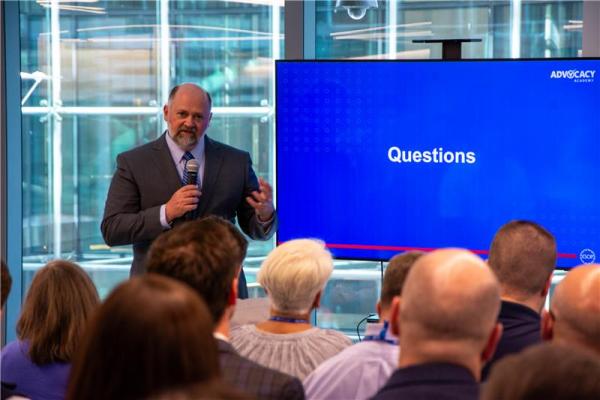In recent years, some private equity firms have begun experimenting with loosely defined employee ownership or shared equity strategies to improve employee engagement at firms they purchase and to present a more socially responsible image. In these cases, the PE investors have stated they are sharing upside potential in the hope that it will catalyze higher productivity, more engagement, and stronger retention among their employees. What they don’t highlight is that their primary goal remains the same: produce more rapid and better returns for the investors, even while factoring a very small initial dilution of investor equity.
In the few examples that private equity firms have shared publicly, they set aside a small portion of the target company's equity at the time of acquisition. It is never more than 10% but generally more in the 3 - 6% range. The managers then inform their new employees that they, too, can potentially share in the upside of a future liquidation event alongside the investors. By creating this construct, the fund managers leverage the possibility of future employee bonuses to achieve their productivity improvement goals among the workforce.
This strategy alone isn’t necessarily controversial, or novel. The concept of providing equity bonuses is routinely used to attract or retain senior executives and key employees, even if dilutive to investors. What is unique is that the equity compensation is being granted to common employees and not just executives. In this regard, The ESOP Association welcomes the possibility that private equity firms might recognize the value of sharing equity and the firm's upside growth with its employees. Unfortunately, this strategy also stretches the definition and boundaries of what constitutes employee ownership. It is formulated much more as a retention and productivity bonus than employee ownership.
But in the last 18 months, these private equity firms have now crossed an additional line and would like to brand some of these experiments as ESOPs. Congress would need to significantly change federal law. These changes would create a new definition and structure for a new form of what would be called an ESOP. Private equity investor funds would have exclusive access to this new model. The law would also introduce brand-new, highly lucrative tax breaks—again, only available to private equity funds. Ultimately, these new and exclusive arrangements are specifically designed to be terminal. Meaning, the goal is to sell and terminate the plan, not create a multi-generational business owned by the employees through a trust in which they hold individual interests and can grow wealth. Ultimately, these new and exclusive arrangements are specifically designed to be terminal. Meaning, the goal is to sell and terminate the plan, not create a multi-generational business owned by the employees through a trust in which they hold individual interests and can grow wealth.
Continued from pg. 5 So, what is driving this newfound focus on sharing equity at private equity firms? To answer that question, it is important to appreciate the current state of private equity.
1.Average private equity hold periods (the length of time an investment firm owns a company before selling it) are the longest in history.
The impact of this is that investors who expected to see their principal and investment returns in a 3–5-year timeframe are now being forced to wait much longer, and they’re growing impatient. It also impacts the ability to raise new funds for future investing and for deployment of existing funds already on hand, known as “dry powder”
2. High turnover and employee engagement are major challenges for private equity firms, particularly given their well-earned reputation for slashing jobs and closing facilities without regard for the impact on people and communities.
By “baking in” a retention bonus into their cost structure and labeling it as “employee ownership”, these PE firms can reduce their turnover and theoretically generate greater employee engagement and productivity. However, despite trying to associate themselves with decades of research on real ESOPs, there is no evidence to demonstrate that redefining a retention bonus as “employee ownership” or as an ESOP will result in the same societal benefit. In reality, these retention bonuses may amount to little more than golden handcuffs on employees who merely want to survive long enough to get a payday after the private equity investor liquidates their investment in the company.
3. Carried interest tax benefits are under threat.
In each of the most recent major tax bills in Congress, increasing scrutiny has been given to the lucrative “carried interest” tax breaks currently granted to PE investors. Even President Trump recently put the tax benefit into play by publicly questioning if it should be continued. Private equity firms have recognized it is in their interest to diversify their tax structure as a hedge against future erosion of the carried interest tax benefit.
4. Finally, private equity firms are working hard to rebrand themselves to blunt their highly negative public image
Their “employee ownership” strategies can reposition their image as inclusive, forward-thinking, and more socially responsible. They are putting on a masterclass in political and business rebranding. By leveraging hard-earned public and lawmaker support for ESOPs, an undeniable aim is to ‘equity-wash’ their reputation—using the language of fairness and inclusion to mask the continuation of extractive business practices. But this isn’t just a PR campaign; it’s a serious policy risk. Private equity is asking for hundreds of billions in taxpayer-funded subsidies to
support their transactions, while trying to write their own narrow regulatory treatment to protect themselves. If these models gain traction under the ESOP banner, they could reshape regulatory treatment and threaten the bipartisan support and tax deferrals that ESOP structures rely upon.
The ESOP Association maintains that part of what private equity firms are doing is simply positioning themselves as partners in inclusive capitalism, even when their business practices remain extractive and harmful to the companies and the communities in which they operate. Private equity’s growing interest in ESOPs is not inherently bad, but their desire for taxpayers to directly fund their scheme and a wholesale redefinition of what it means to be an ESOP is fraught with risk for existing ESOP companies and the 14 million current ESOP plan beneficiaries.
The ESOP brand, built on decades of bipartisan support and trust, potentially becomes a shadow of its former self. Worse still, by allowing the conflation of actual ESOPs with this new private equity model, any notable failure would likely produce a cascade of policy reactions that could erase the modest but effective tax deferrals that sustain genuine employee ownership at real ESOPs. Finally, the policy bandwidth that will be consumed by these initiatives will likely swamp and drown out many other, more necessary and productive policy initiatives that could open employee ownership and ESOPs to millions of additional Americans.
Sources
[1] https://www.nceo.org/hubfs/system/files/inline-files/Private_Equity_and_Employee_Ownership.pdf
[2] https://www.institutionalinvestor.com/article/2elg61wlzz0uflebs0b28/corner-office/the-pe-glut-a-towering-3-6tr-of-value-is-locked-in-29-000-unsold-
companies
[3] https://www.cnbc.com/2025/02/07/trump-carried-interest-loophole.html
[4] https://cepr.net/publications/private-equity-and-workers-saying-the-quiet-part-out-loud/
[5] https://www.forbes.com/councils/forbesagencycouncil/2022/01/04/elasticity-and-speed-in-rebranding-to-unlock-private-equity-portfolio-company-value/









